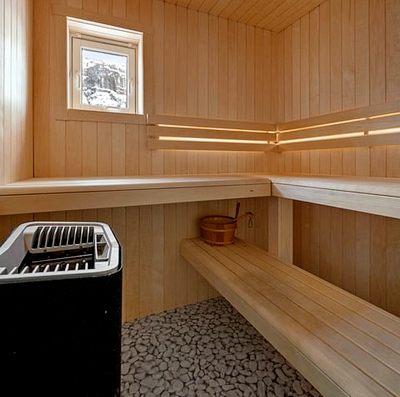From a big list of heaters for a sauna to choose from, you might feel overwhelmed and wanting to learn more about your options, their pros and cons. In this post, you will find a list of the best heaters for a sauna. You will learn which heater is best for an indoor sauna, which heater is best for outdoor sauna and find information on electric, infrared, propane, gas and other types of sauna heaters.
Сhoosing a right heater for your sauna is important; Depending on the type of a heater, there will be differences in how fast inside of a sauna heats up, how much energy is used and what type of heaters are easier to install. What heater you choose depends on whether your sauna is indoors or outdoors, its size, power source available and type of sauna you have (for example Finnish sauna has low humidity and high temperatures vs Russian style banya with high humidity and lower temperatures, you can find a comparison here).
How to choose a sauna heater?
When choosing a sauna heater, answer a list of questions to see which one is best suited for your needs.
- What is the cheapest and easiest to access form of energy that you can connect your sauna heater to? This will help with how much you pay to use your sauna on a regular basis and how often you can power it.
- How often will you use sauna and how long you want to use it for (per session)? This will help to determine what type of heater can keep the heat longest if you intend to have long bathing sessions. If you intend to do short sessions (20-25 minute each) but frequently, electric heaters might be better for you than wood burning one, for example.
- Do you have time to heat the sauna room or do you want it to be mostly automated? If you choose a wooden heated sauna, you will need to spend time preparing to use it and it will involve some physical work.
- What power heater do you require? This will depend on the size of your sauna.
- How big is your sauna? This will determine the heater you pick because they differ in size. Make sure that the heater is at least a foot (30 cm) away from people, however this distance will depend on each heater. Protective sheaths can help reduce this required distance.
- How tall if your heater compared to the height of the ceiling of a sauna room? The distance between your heater and the ceiling should be at least 160 cm (5 feet 2″).
Answering these questions will help you decide which sauna heater to pick depending on size, session length, ceiling height, power sources and more. You can even install two heaters in one sauna, and it will depend on the size of your sauna (for example 2 wood burning heaters in one large sauna to increase heating efficiency).
Wood burning heaters
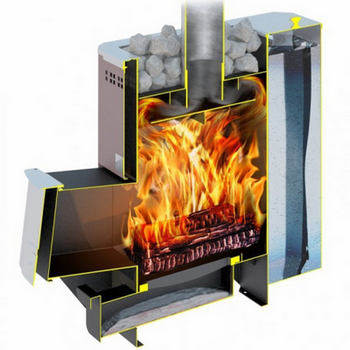
Wood burning heaters are great for allowing to create a traditional sauna experience. With a wood burning heater, you add wooden logs that burn and create heat in a sauna. You can see, smell and hear the wood crackling, which adds a feeling of comfort and coziness to the whole bathing experience.
Wood burning heaters allow uniform and quick heating of the air in a sauna, and can even heat bigger sauna rooms pretty well. Another benefit of wood burning heaters is that they are often compact and don’t take much space, making them a good choice if there’s lack of space in a sauna room. Downsides are that with them it’s hard or impossible to regulate the temperature of air that you wish to achieve. Rocks that are placed on top and water is splashed on are usually there to regulate the temperature.
So, what type of sauna can you use a wood burning heater for? A wood burning heater can suit a traditional outdoor sauna, especially if you don’t have electricity access there. You can also install a wood burning heater in a traditional sauna.
Overall, wood burning saunas might suit people outside of bigger cities or those looking for a traditional experience. Wood burning heaters are often installed in bigger saunas (around over 20 m3), for example in countries like Finland.
Also, if you intend to keep your sauna hot for many hours (over 3-4 hours), then a wood burning sauna heater isn’t the best option, as it will require you to keep adding wooden pellets. However, there are single-fired wood burning heaters, that can keep a sauna warm for much longer, even up to the next morning. But they can take a few hours to heat a room.
| Pros of wood burning sauna heaters | Cons of wood burning sauna heaters |
| Allow to create a traditional, cozy sauna feel | Might be harder to install |
| Nice smell & sound of burning wood, using renewable source of energy | Will require wood supply to use |
| Good & uniform heating of varying sauna sizes | Emits gases upon burning |
| Can be quite compact | Can be harder to achieve and maintain specific temperatures in a sauna room (however heats the air quickly) |
| Good option if you don’t have electricity or gas | Will require cleaning of the flue & ash removal |
| Long-lasting heaters | Some countries ban domestic burning of wood |
| Heat the air generally faster than electric heaters | Not the best option if you want to use sauna for long hours (will need constant feeding of wood) |
Electric heaters
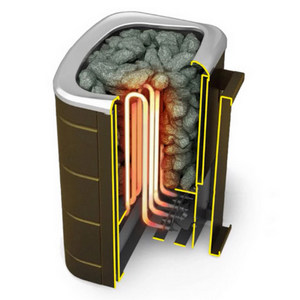
Electric heaters are probably the most popular type heaters for a sauna. They are convenient to purchase and install, and are popular for indoor saunas of varying sizes. You are also likely to find it easier to search for someone to repair or maintain an electric heater.
However, if electricity costs a lot in your area, it might lead to a high bill if sauna is used frequently. Electric heaters are convenient because you can install them for indoor or outdoor sauna (if there’s access to electricity), and even in a traditional sauna. They can be easier to install, but you need to take into an account electricity bills that you will have to cover later.
Overall, electric heaters are great for indoor saunas.
| Pros of electric sauna heaters | Cons of electric sauna heaters |
| Easier to install than some other heater types | Requires electricity & electricity bills can be high (if it costs more than wood for example) |
| Can be installed for both indoor and outdoor saunas | Needs wiring to withstand higher electricity load |
| Doesn’t emit any harmful gases | Requires professional installation to avoid any hazards (electricity) |
| Easy to find and purchase | |
| Easy to maintain and use | |
| You can choose and reach wanted temperatures in a sauna; they heat the air well & quickly | |
| Great for both short and long sessions (can turn on and off to use for as long as you need) |
Infrared heaters
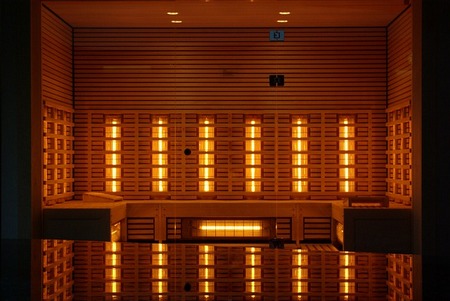
Infrared sauna heaters are also great option for various sauna types, and are increasing in popularity. They are good options as they heat your body directly, instead of heating the air. Infrared saunas are gentler and can be used by different people. That’s because there’s no fuel burning or oxygen burning. And because air is not heated, it doesn’t affect your lungs.
Also, they can be installed in smaller spaces and are don’t use too much energy. You can even install an infrared type sauna in a flat. With infrared type heaters, you will need to install a specific number of these heaters depending on a size of a sauna room.
| Pros of infrared sauna heaters | Cons of infrared sauna heaters |
| Can be installed in smaller spaces, even smaller flats | Requires professional installation to avoid any hazards (electricity) |
| Energy efficient | |
| Gentle heating, can be used by diversity of people | |
| Quiet, safe and long-lasting, easy to maintain | |
| Doesn’t emit any fumes | |
| Easy to operate and good for any session lengths |
Gas heaters for sauna
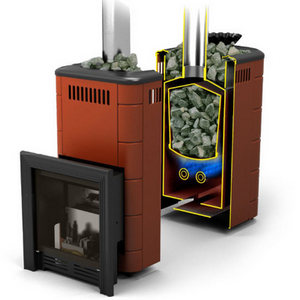
Gas heaters are another option for saunas. They are often used in settings where you don’t have electricity, but have a source of propane or natural gas.
Gas can be a cheaper type of fuel than electricity, making it a good alternative for a sauna heater. That’s especially true for smaller saunas: if a sauna is around 15 sq meters (160 sq feet), heat in the room will last for a few hours, and the heater can be turned off once your sauna is hot enough.
| Pros of gas sauna heaters | Cons of gas sauna heaters |
| Convenience, especially if you have access to gas | Might need certifications of professional installations for safety reasons |
| Practical | Good venting required due to combustion gases |
| Often not expensive to run | Require maintenance to make sure it is working properly & safely |
